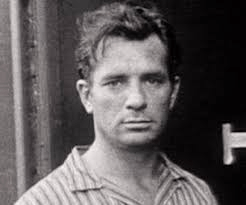Left without a new book I had ordered but which had not arrived, I went to our bookshelves, to find something to read in the meantime. I selected On the Road by Jack Kerouac, which I had read and reviewed on this blog in October 2020. I have now read it again, and I think I enjoyed it more this time.
Rather than re-review it, I’m going to share some of the research I have done on the book and its author.
Jack Kerouac
Jean-Louis Lebris de Kerouac was born in 1922 in Lowell, Mass to an immigrant French-Canadian family. His mother tongue was French and it took him some time to become fluent in English. He was brought up in a strict Roman Catholic environment. His father’s business was not successful, he drank heavily, and the family was short of money. However, young Jack was a good student, who excelled at football and he won a scholarship to Columbia University. At Columbia, he met the poet Allan Ginsberg (1926-1997) who would become the character Carlo Marx in On the Road, and the writer William S Burroughs (1914-1997) who would become the character Old Bull Lee. He also met Neal Cassaday, a wildly-driven intellectual who would become the central figure, Dean Moriarity in On the Road. These four men became the founders of the Beat Generation which loved bebop music, alcohol, drugs, sex and wild experiences. Kerouac greatly admired Neal Cassady for his total lack of inhibitions, his enthusiasm, his great spirit of adventure, his love of women, risk and fast cars, idealized him and considered him a hero.
Kerouac dropped out of Columbia when his football career ended. He joined the merchant marine in 1942 and wrote The Sea Is My Brother which was published in 2011, forty years after his death. For a short time he was in the US Navy reserve, but was discharged honorably on psychological grounds (a diagnosis of schizoid personality).
In 1947, Kerouac and Cassady embarked on a cross-country trip, after which the writer completed Town and the City which included the details of his daily life and was published in 1950 having had 400 pages edited out. In 1949 he began work on On the Road. In its original form, Kerouac typed it on a continuous sheet of paper 120 feet long, during 22 days in April 1950, relying on copious notes. Though the book was written quickly, it was not well received by publishers who objected to its sexual content (including homosexuality), drug use and its experimental writing style. According to Kerouac, On the Road “was really a story about two Catholic buddies roaming the country in search of God. And we found him.” According to his biographer, historian Douglas Brinkley, On the Road has been misinterpreted as a tale of companions out looking for kicks, but the most important thing to comprehend is that Kerouac was an American Catholic author – for example, virtually every page of his diary bore a sketch of a crucifix, a prayer, or an appeal to Christ to be forgiven.
For the next several years Kerouac continued writing and traveling, taking long trips through the U.S. and Mexico. He often experienced episodes of heavy drinking and depression. During this period, he finished drafts of what became ten more novels, including The Subterraneans , Doctor Sax, Tristessa and Desolation Angels, which chronicle many of the events of these years.
In 1954 Kerouac discovered The Buddhist Bible in the San Jose library; this was the beginning of his interest in eastern religion and philosophy, of which The Dharma Bums is an example.
Wikipedia says, “Kerouac found enemies on both sides of the political spectrum, the right disdaining his association with drugs and sexual libertinism and the left contemptuous of his anti-communism and Catholicism; characteristically, he watched the 1954 Senate McCarthy smoking marijuana and rooting for the anti-communist crusader, Senator Joseph McCarthy.” and “Kerouac’s novel is often described as the defining work of the post-World War II Beat Generation and Kerouac came to be called “the king of the beat generation,” a term with which he never felt comfortable. He once observed, “I’m not a beatnik. I’m a Catholic”, showing the reporter a painting of Pope Paul VI and saying, “You know who painted that? Me.” (Kerouac was, in fact a portrait painter, having painted Joan Crawford, Truman Capote, Dody Muller and even Cardinal Montini.)
On October 20, 1969, Kerouac vomited blood and was taken to the hospital in St Petersburg, Florida, where he was found to have an esophageal hemorrhage. He was given transfusions and an operation, but cirrhosis of the liver would not allow his blood to clot, and he never regained consciousness. At the time of his death, he was living with his third wife, Stella Sampas Kerouac, and his mother, Gabrielle. Kerouac’s mother inherited most of his estate.
Jack Kerouac was clearly a man in fraught search of himself. There are many conflicts in his character. But even if we set aside the subjects of his novels because we are unsure of the rationale, one has to admit that his characterisations, his descriptions of scenes, and the urgency of his writing are brilliant.
